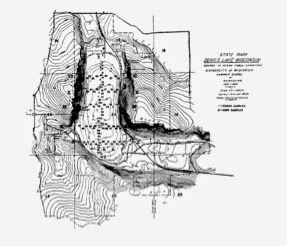Lacustrine sedimentary systems are spatially and temporally
variable, but can include considerable quantities of organic-rich sediment. Seventy-five
years ago, Twenhofel and McKelvey examined the sediment of Devils Lake, a small
closed lacustrine system in Wisconsin. Their documentation of factors such as
composition, color, and “bacteria” revealed shore-parallel zonation of
sedimentary attributes. They illustrated abundant bacteria in the deeper
waters, which they interpreted to be the result of anoxic conditions in the
poorly circulated lake.
Granulometric
characterization is a fundamental tool for sedimentologic analyses, and ideally
provides unique insight into sedimentary dynamics. Here, Barusseau and Braud show
that many sands of the recent deposits of the shoreface of the Golfe du Lion
(Mediterranean Sea, France) represent mixtures of four sediment types. Each
sediment type is interpreted to be distinct, but that these can be mixed to
create asymmetric grain size distributions. Areas with exclusive or dominant
transport processes include mixtures that tend toward a log-normal grain-size
distribution. These findings provide insights into possible mechanisms
underlying the deposition of sediments in the coastal environments, results
that may have use in paleogeographic reconstructions of the coastal zone and
basin borders in geologic analogs.
Although the effects of
shape and roughness on particle settling velocity are broadly understood,
settling velocities of biogenic particles that have the quality of grain-size dependent
roughness are less well constrained. This work by Joshi et al. addresses
that gap in knowledge by examining the properties of maërls. The results
indicate that maërl is suspended at lower current speeds than equant sediment,
and how unsorted siliciclastic and maërl sediment can be advected differentially
to deposit unsorted maërl gravel and fine sand. These results reveal how the
hydrodynamic behavior of maërl may explain its propensity to form spatially
well-defined "beds" or beaches with very low amounts of sand.
Siliciclastic systems are
lumped into wave- or tide-dominated classes, and many detailed facies and
sequence-stratigraphic analyses interpret pronounced changes to a shift from
one to the other caused by major (commonly external) perturbations. To explore
fundamental assumptions of some of these studies, Legler et al. document distal
deposits near the pinchout of the widely studied lower Sego Sandstone in the
Book Cliffs, western Colorado, a unit generally regarded as the type example of
an ancient tide-dominated delta. The analysis of facies and stratigraphic
architecture suggests that coeval waves and storms were equally prominent in
controlling its deposition. The re-interpretation of the lower Sego Sandstone
as a mixed, tide- and wave-influenced delta is important in three ways: (1) the
prevailing, widely used archetype of an ancient tide-dominated delta should be
viewed as recording a wider mixture of depositional processes; (2) the
recognition that wave- and tide-dominated deposits can be coeval; and, as a
result, (3) sequence stratigraphic framework of the lower Sego Sandstone and
other ancient tide-dominated/influenced, regressive strata may need to be
re-assessed.



